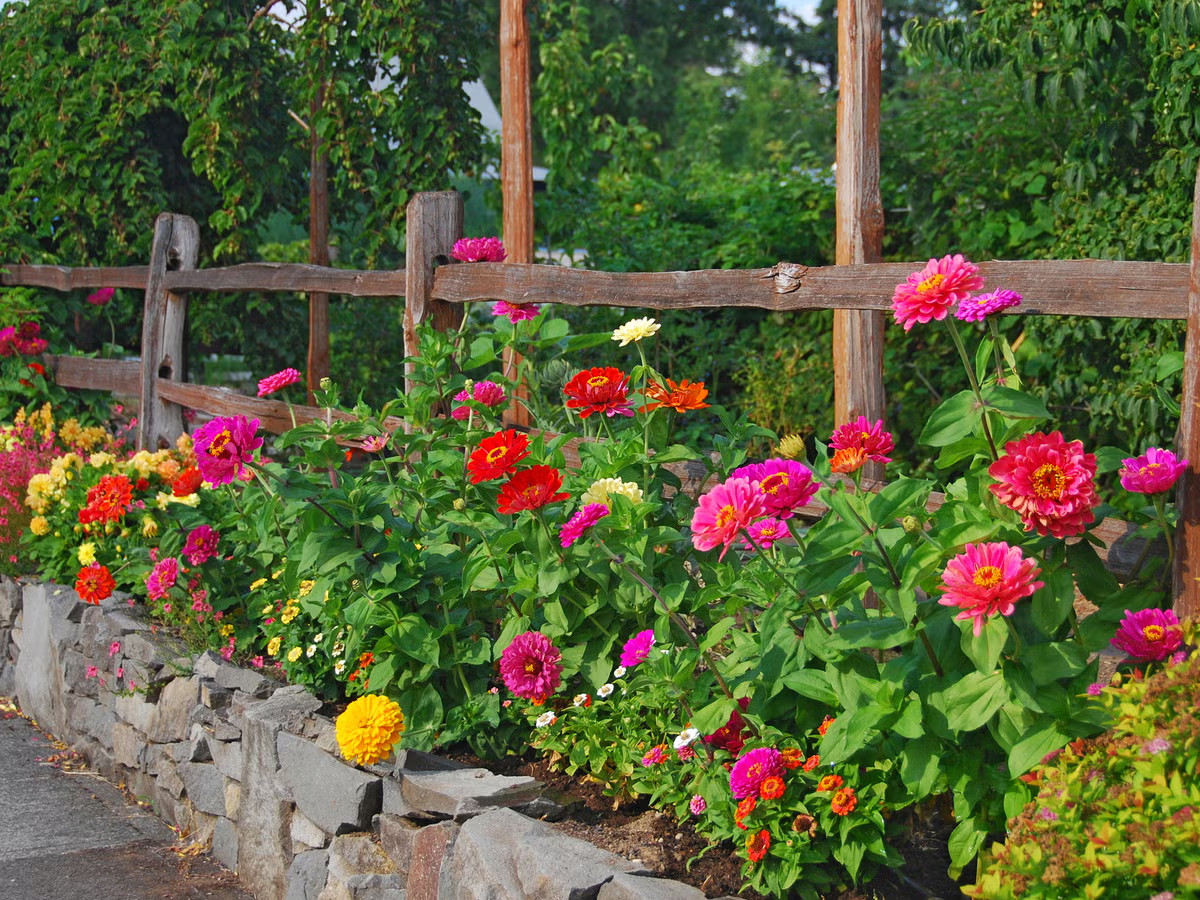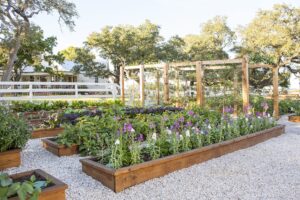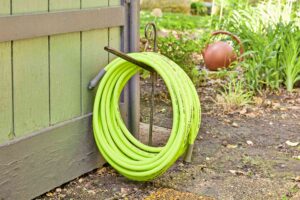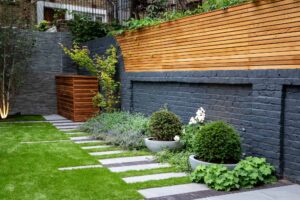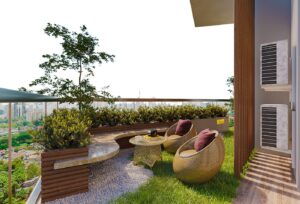10 Creative Zinnia Garden Along Fence Ideas for a Cozy Yard
Transform your ordinary fence line into a vibrant showcase of color and life with zinnias, one of America’s most beloved garden flowers. These versatile blooms offer the perfect solution for beautifying that often overlooked stretch along your property boundary. Whether you’re working with a weathered wooden fence that needs some aesthetic enhancement or a pristine white picket fence that’s begging for floral companions, zinnias provide an accessible, low-maintenance option for gardeners of all skill levels.
In this comprehensive guide, you’ll discover ten innovative approaches to incorporating zinnias along your fence line, creating an inviting atmosphere that elevates your entire yard. From contemporary designs that complement modern homes to cottage-inspired arrangements that exude charm and nostalgia, these ideas will help you maximize your property’s potential while expressing your personal style through thoughtful gardening.
Understanding Zinnias: The Perfect Fence-Line Flowering Plant
Before diving into specific design concepts, it’s worth appreciating why zinnias make such excellent candidates for fence-line gardening. Native to scrublands and dry grasslands from the southwestern United States to South America, zinnias have evolved to thrive in challenging conditions, making them remarkably adaptable to various garden environments.
According to the United States Department of Agriculture (USDA), zinnias are annual flowers that grow quickly from seed and produce blooms continuously from early summer until the first frost. The USDA Plant Hardiness Zone Map (https://planthardiness.ars.usda.gov/) can help you determine the optimal planting time for your specific region, ensuring your zinnia fence garden starts on the right foot.
Zinnias come in an impressive array of colors, shapes, and sizes, giving you numerous options to suit your aesthetic preferences. From towering varieties that reach heights of four feet to compact border zinnias that maintain a neat twelve-inch profile, these adaptable flowers offer solutions for any fence type or gardening challenge.
Key Benefits of Using Zinnias Along Fences
When planning your fence-line garden, consider these significant advantages that zinnias bring to the table:
Long blooming season that provides continuous color from June through October in most climate zones Exceptional heat and drought tolerance once established Pollinator-friendly blooms that attract butterflies, bees, and hummingbirds Excellent cutting flowers that allow you to bring the garden indoors Minimal care requirements compared to many perennial options Cost-effective solution with seeds providing excellent value
The National Gardening Association reports that zinnias rank among the top ten annual flowers for American home gardeners, with their popularity stemming from this winning combination of visual impact and practical benefits.
Common Zinnia Varieties for Fence Gardens
Before exploring specific design approaches, familiarize yourself with some popular zinnia varieties that work beautifully in fence-line applications:
| Variety | Height | Bloom Size | Special Features | Best Uses |
|---|---|---|---|---|
| Zinnia elegans ‘Benary’s Giant’ | 36-48″ | 4-6″ | Huge double blooms, sturdy stems | Tall backdrop plantings, cutting gardens |
| Zinnia ‘Profusion’ Series | 12-18″ | 2-3″ | Disease resistant, continuous bloom | Front borders, small spaces |
| Zinnia ‘Zahara’ Series | 12-18″ | 2-3″ | Superior heat and humidity tolerance | Hot climates, low-maintenance areas |
| Zinnia ‘Queen’ Series | 18-24″ | 2-4″ | Unique bicolor and striped patterns | Focal points, decorative impact |
| Zinnia elegans ‘Cut and Come Again’ | 24-30″ | 3-4″ | Produces more blooms when cut regularly | Cutting gardens, medium-height borders |
Now that you understand the fundamentals, let’s explore ten creative approaches to incorporating zinnias along your fence line for maximum impact and enjoyment.
1. The Graduated Zinnia Border: Creating Depth and Dimension
One of the most visually appealing approaches to fence-line gardening involves creating a graduated border that places taller zinnia varieties at the back (nearest the fence) with progressively shorter varieties toward the front. This technique, reminiscent of traditional English border gardens, creates a lush, layered appearance that maximizes visual interest while ensuring all plants receive adequate sunlight.
To execute this design effectively, you’ll want to prepare a bed that extends at least three feet from your fence. Select three to four zinnia varieties of differing heights, and arrange them in rows with the tallest (such as ‘Benary’s Giant’ or ‘State Fair’) positioned within six inches of the fence. Medium-height varieties like ‘Cut and Come Again’ or ‘Queeny Lime Orange’ should occupy the middle section, while compact varieties such as the ‘Profusion’ or ‘Zahara’ series create a polished front edge.
What makes this approach particularly effective is the way it transforms an ordinary fence into a backdrop for a living tapestry of color. The graduated arrangement ensures that all blooms remain visible, creating the impression of abundant flowers while maintaining neat organization.
For maximum impact, consider these color strategy options:
Monochromatic Gradient: Choose varieties in the same color family (pinks, purples, etc.) but in differing intensity levels for a sophisticated, cohesive look.
Complementary Contrast: Pair colors that sit opposite each other on the color wheel (blue/orange, purple/yellow) for dramatic visual energy.
Sunset Palette: Blend reds, oranges, and yellows to create a warm, inviting border that captures the magic of sunset hues.
Your graduated border will require some strategic maintenance. Taller varieties may need staking in windy locations, and regular deadheading (removing spent blooms) will encourage continuous flowering throughout the season. The effort pays dividends in a fence line that appears professionally designed and thoughtfully executed.

2. Color Block Zinnia Fence Garden: Bold Modern Statements
If your home features contemporary architecture or you simply prefer clean, graphic design elements, consider creating a color-block effect with your zinnia fence garden. This approach employs distinct sections of single-color zinnias planted in substantial groupings to create a bold, modern aesthetic.
To achieve this look, divide your fence line into segments of equal or varying lengths. Within each segment, plant a single zinnia color in dense formation. For example, you might create a three-foot section of vibrant red ‘Benary’s Giant’ zinnias, followed by a three-foot section of pure white ‘Oklahoma White,’ then a section of deep purple ‘Purple Prince.’
The key to success with this approach lies in committing fully to each color block—avoid the temptation to mix in other flowers or create transitions between sections. The sharp visual shifts between colors create the graphic impact that makes this design distinctive and contemporary.
For maximum effect, consider these strategic approaches:
Repeating Pattern: Create a pattern that repeats along the fence (red, white, blue, red, white, blue) for a rhythmic effect.
Graduated Intensity: Arrange blocks from lightest to darkest within the same color family for subtle sophistication.
Property Line Enhancement: Use bright colors at property corners or entry points to create natural wayfinding elements.
This approach works particularly well with modern horizontal fencing, where the linear elements of the fence complement the structured planting blocks. The result is a thoroughly contemporary garden aesthetic that offers tremendous visual impact with relatively simple implementation.
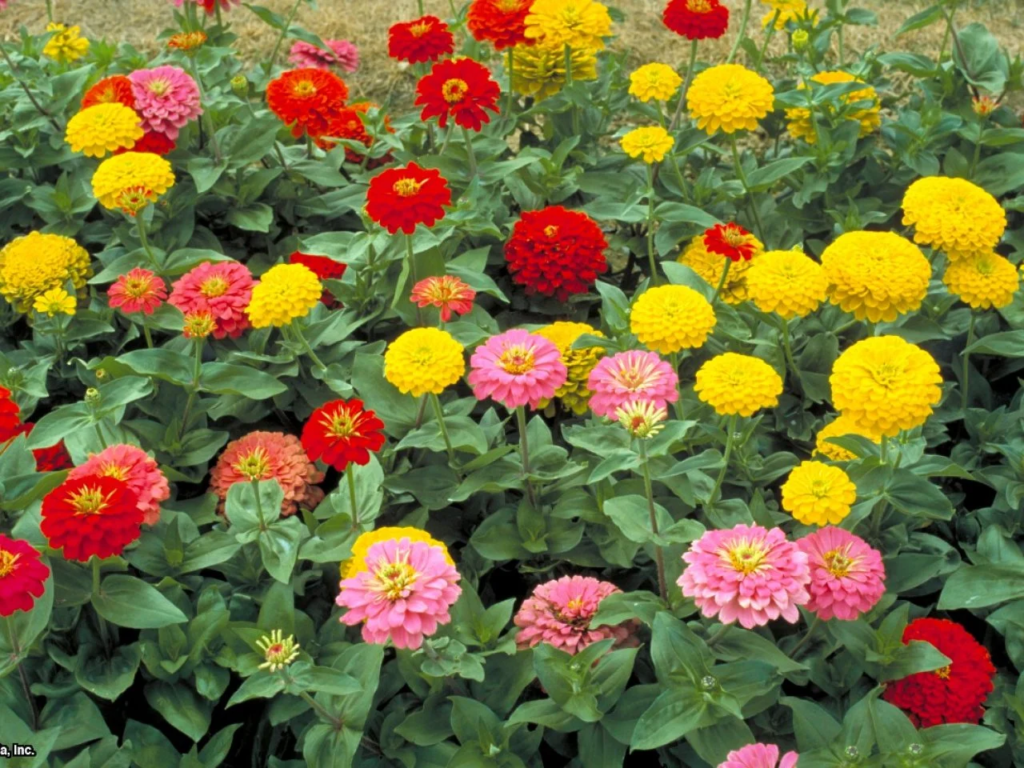
3. The Pollinator Highway: Functional Zinnia Fence Gardens
While aesthetic considerations often drive garden design, your zinnia fence garden can serve important ecological functions while looking beautiful. Creating a “pollinator highway” along your fence line supports native bees, butterflies, and other beneficial insects while adding animation and life to your garden space.
According to the United States Forest Service (https://www.fs.usda.gov/wildflowers/pollinators/), pollinator populations face significant challenges from habitat loss and environmental factors. Your fence-line garden can become part of the solution by providing essential food sources and habitat.
For this approach, select zinnia varieties specifically known for attracting pollinators. Single-flowered varieties often provide easier access to nectar and pollen than densely double types. The ‘Profusion’ series, with its open-centered blooms, consistently ranks among the best zinnias for butterfly attraction. Combine these with other pollinator-friendly plants for maximum ecological benefit.
| Plant Type | Recommended Varieties | Pollinator Appeal | Planting Location |
|---|---|---|---|
| Tall Zinnias | ‘Oklahoma’ series, ‘Benary’s Giant’ | Butterflies, bees | Back row (fence side) |
| Medium Zinnias | ‘Profusion’ series, ‘Zahara’ series | Butterflies, native bees | Middle row |
| Companion Plants | Mexican sunflower (Tithonia), Salvia | Hummingbirds, butterflies | Interspersed or grouped |
| Early Season Plants | Sweet alyssum, borage | Early-emerging bees | Front edge |
For maximum ecological benefit, incorporate these practices:
Continuous Blooming: Include early, mid, and late-season flowering plants to provide nectar throughout the growing season.
Pesticide Avoidance: Commit to avoiding chemical pesticides that harm beneficial insects. The USDA Agricultural Research Service provides guidance on integrated pest management that protects pollinators (https://www.ars.usda.gov/oc/br/pollinators/index/).
Water Source: Consider adding a small water feature or butterfly puddling area near your zinnia fence garden.
This approach transforms your fence line into a vibrant ecosystem that brings your garden to life with the movement and activity of beneficial insects. The ecological benefits extend beyond your property lines, creating stepping-stone habitats that help pollinators navigate through urban and suburban landscapes.

4. The Living Privacy Screen: Tall Zinnia Varieties for Enhanced Seclusion
If your existing fence provides insufficient privacy or you simply want to enhance the feeling of seclusion in your yard, tall zinnia varieties can create a seasonal living screen that adds both privacy and beauty. This approach works particularly well with low or open-style fencing that defines boundaries without blocking views.
To create an effective privacy screen, focus on the tallest zinnia varieties, which can reach heights of 3-4 feet. ‘Benary’s Giant,’ ‘State Fair,’ ‘Giant Cactus,’ and ‘California Giant’ all offer impressive height when properly grown. Plant these varieties in a dense formation approximately 9-12 inches apart, close enough to create a solid visual barrier but with sufficient spacing to prevent disease issues.
For maximum effectiveness, consider these implementation strategies:
Double-Row Planting: Create two staggered rows of tall zinnias for increased density and depth.
Support System: Install inconspicuous stakes or string supports to prevent tall plants from bending during summer storms.
Strategic Placement: Focus your privacy screen on areas where neighbors’ views most directly impact your outdoor living spaces.
The temporary nature of this annual privacy solution offers certain advantages over permanent structures or hedges. You can adjust your strategy seasonally, perhaps implementing the screen only during the months when you use your outdoor spaces most frequently. Additionally, you avoid the long-term commitment and maintenance requirements of perennial hedges.
For enhanced effectiveness, consider these companion plantings:
Fast-Growing Annual Vines: Morning glories or black-eyed Susan vine (Thunbergia) can be trained up the fence behind your zinnias for additional height and coverage.
Complementary Tall Annuals: Incorporate cosmos or cleome for textural variety within your living screen.
Ornamental Grasses: Add movement and late-season interest with annual grasses like purple fountain grass.
This approach transforms your fence from a simple boundary marker to the foundation of a lush, colorful privacy solution that enhances your outdoor living experience while maintaining positive neighborhood relations.

5. The Cutting Garden Fence: Practical Beauty with Harvestable Zinnias
If you enjoy bringing the garden indoors, your fence line offers the perfect location for a dedicated cutting garden. Zinnias rank among the finest cutting flowers available to home gardeners, with sturdy stems, long vase life, and prolific blooming that won’t leave your garden looking depleted after harvesting.
This approach emphasizes accessibility and productivity, organizing zinnia varieties specifically selected for cutting in a way that allows easy harvest without disturbing the garden’s overall appearance. The fence provides both a structural backdrop and potential support for your cutting garden.
To implement this effectively, select zinnia varieties known for their excellence as cut flowers:
| Variety | Stem Length | Vase Life | Special Characteristics | Best Colors for Cutting |
|---|---|---|---|---|
| ‘Benary’s Giant’ | 18-24″ | 7-10 days | Extra-sturdy stems, huge blooms | Deep purple, scarlet, lime |
| ‘Queen Red Lime’ | 18-24″ | 7-10 days | Unusual color combinations | Red-lime, rose-lime |
| ‘Oklahoma’ series | 16-20″ | 7-14 days | Smaller heads, exceptional vase life | All colors reliable |
| ‘Cactus Flower’ | 20-24″ | 5-7 days | Unique quilled petals | Bright colors show texture best |
| ‘Zinderella’ series | 18-24″ | 7-10 days | Scabiosa-type centers | Purples and lilacs |
For optimal functionality, arrange your cutting garden in rows perpendicular to the fence, creating accessible “aisles” for harvesting. Space plants slightly farther apart than in typical ornamental plantings—about 12-18 inches—to encourage larger blooms and prevent disease issues. Install a simple irrigation system, such as soaker hoses, to ensure consistent moisture for premium flower production.
The key to maintaining an attractive appearance while regularly harvesting is strategic cutting technique. Always cut stems in the morning when plants are fully hydrated, and make cuts just above a leaf node where new branching will occur. This encourages the plant to produce multiple new stems for continued flowering. Regular harvesting actually increases your total bloom production while keeping the fence line looking fresh and tidy.
Consider these enhancements to your cutting garden fence:
Succession Planting: Stagger seed starting times to ensure continuous production throughout the season.
Companion Herbs: Incorporate fragrant herbs like basil or mint that pair well with zinnias in bouquets.
Labeling System: Install discreet plant markers to track variety performance and color placement.
This approach transforms your fence line from purely decorative to beautifully functional, providing months of fresh flowers for your home while maintaining an attractive garden appearance.

6. The Rainbow Spectrum Fence: Creating Flow with Color Progression
For a truly show-stopping fence line display, consider implementing a rainbow spectrum approach that creates a gradual color progression along the entire length of your fence. This technique draws the eye along the property line, making it appear more expansive while creating a cohesive, planned appearance.
To execute this design effectively, you’ll need to carefully select zinnia varieties that offer true, clear colors representing each segment of the color spectrum. Begin at one end of your fence with reds, then progress through oranges, yellows, greens, blues, and purples, creating a gradual transition between each color section.
The spectrum approach requires more detailed planning than some other methods, but the results justify the effort. Create a planting plan that allocates specific spacing to each color segment, ensuring smooth transitions. For a sixty-foot fence, you might allocate ten feet to each main color group, with careful blending at transition points.
Consider these implementation strategies:
Color Blocking with Blended Transitions: Plant dense sections of each pure color, with small transition zones where the two adjacent colors intermingle.
Consistent Variety Selection: Use the same zinnia variety (such as ‘Benary’s Giant’) throughout the spectrum to maintain consistent height and flower form.
Graduated Saturation: Within each color segment, plant the most intense, saturated version of the color at the center, with slightly softer tones at the edges to facilitate transitions.
The rainbow spectrum approach creates different effects depending on viewing angle. Viewed from one end, the fence presents a clear color progression that draws the eye forward. From the center of the yard looking outward, the fence creates a colorful embrace that frames the property in a cohesive, artistic manner.
For maximum impact, consider these enhancements:
White Bookends: Begin and end the spectrum with sections of pure white zinnias to frame the color display.
Repetition Elements: Include occasional “pops” of white or black zinnias at regular intervals to create rhythm and unity.
Complimentary Foliage: Incorporate silver-leaved plants like dusty miller at transition points to enhance color separation.
The rainbow spectrum transforms your fence from a utilitarian boundary into an artistic statement that demonstrates thoughtful planning and garden mastery. While requiring more detailed planning than some approaches, the visual payoff makes this technique especially rewarding for gardeners seeking to create conversation-starting landscapes.
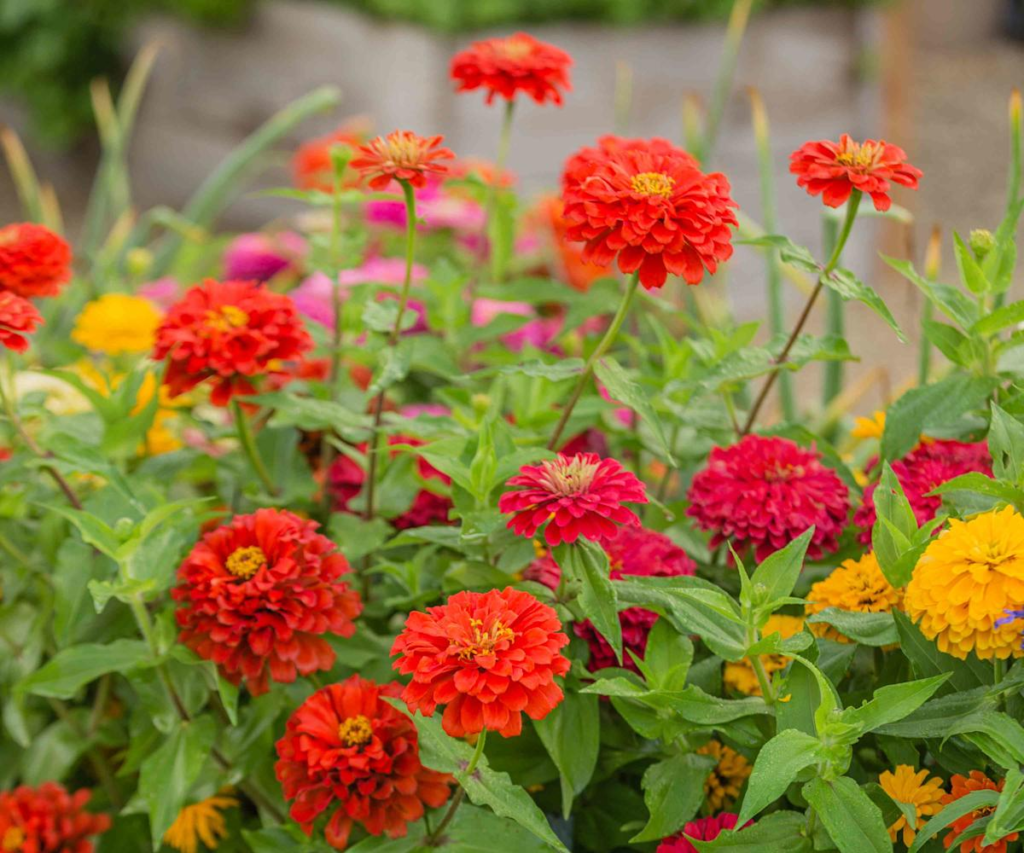
7. The Cottage Garden Fence: Informal Charm with Zinnia Foundations
If your aesthetic leans toward relaxed, romantic garden styles, consider creating a cottage-inspired fence garden with zinnias as the foundational element. This approach embraces the informal abundance and seemingly effortless charm of traditional cottage gardens while using the reliable performance of zinnias to ensure success.
Unlike more structured approaches, the cottage garden fence style intentionally blurs boundaries between species, creating natural-looking plant communities that appear to have evolved organically. Zinnias serve as the reliable backbone that provides consistent color while complementary plants add texture, movement, and seasonal variation.
To implement this style effectively, select zinnia varieties that embody cottage garden characteristics—medium heights, abundant blooming, and colors that complement traditional cottage plants. The ‘Cut and Come Again’ mix, ‘Queeny’ series, and ‘Peppermint Stick’ offer excellent options with their informal blooming habits and charming color patterns.
For authentic cottage garden character, incorporate these complementary elements:
Vertical Accents: Include larkspur, cleome, or annual delphinium for height variation.
Airy Fillers: Incorporate cosmos, love-in-a-mist (Nigella), and annual baby’s breath for light, ethereal texture.
Cascading Elements: Add trailing nasturtiums, sweet alyssum, or calibrachoa to soften the fence line.
The planting strategy for a cottage garden fence emphasizes relaxed groupings rather than rows or blocks. Create irregular drifts of 5-7 plants of each variety, allowing them to visually merge into one another. Varying the distance from the fence adds to the natural appearance—some plants should nestle against the structure while others stand proud a foot or more away.
For seasonal progression and continuous interest, layer in these elements:
Spring Bulbs: Plant tulips and daffodils the fall before for early season color before zinnias reach maturity.
Quick Bloomers: Include fast-growing annuals like calendula and bachelor’s buttons for early color while zinnias develop.
Late-Season Interest: Plant African marigolds and asters to maintain color as the season progresses into fall.
The cottage garden fence approach transforms rigid boundaries into soft, welcoming transitions that invite exploration and evoke nostalgic connections to traditional gardening practices. The United States National Arboretum provides historical context for American cottage gardening traditions here: https://www.usna.usda.gov/gardens/collections/historic-gardens.

8. The Edible Landscape Fence: Combining Zinnias with Kitchen Garden Elements
Increasingly, American gardeners are blurring the lines between ornamental and productive gardens, recognizing that beauty and utility need not be mutually exclusive. Your fence line offers an excellent opportunity to implement this integrated approach, combining the ornamental qualities of zinnias with herbs, vegetables, and edible flowers in an attractive, functional border.
According to the USDA’s National Institute of Food and Agriculture (https://www.nifa.usda.gov/about-nifa/how-we-work/extension), interest in home food production has increased dramatically in recent years, with more Americans seeking to understand the origins of their food and develop self-sufficiency skills. Your edible landscape fence can contribute to this movement while creating a uniquely beautiful garden feature.
To implement this approach effectively, select zinnia varieties that complement culinary plants both aesthetically and culturally (similar growing requirements). Medium-height varieties (18-24 inches) like the ‘Zahara’ and ‘Profusion’ series work particularly well, providing color without overwhelming smaller edible plants.
Consider these strategic pairings:
| Zinnia Variety | Companion Edibles | Aesthetic Benefits | Practical Benefits |
|---|---|---|---|
| ‘Profusion Fire’ (orange-red) | Basil, tomatoes | Complementary colors | Attracts pollinators for tomatoes |
| ‘Zahara Yellow’ | Purple basil, eggplant | Color contrast | Attracts beneficial insects |
| ‘Peppermint Stick’ | Sage, oregano, thyme | Textural contrast | Drought tolerance compatibility |
| ‘Benary’s Giant Lime’ | Red-leafed lettuce, strawberries | Unexpected color pairing | Visual highlight for edibles |
| ‘Queeny Lime Orange’ | Bronze fennel, dill | Sophisticated color harmony | Supports beneficial insects |
For maximum functionality, implement these design strategies:
Access Paths: Create stepping stone paths at regular intervals to allow harvest access without compacting soil.
Height Graduation: Position taller edibles (tomatoes, peppers) near the fence, medium plants (zinnias, bush beans) in the middle, and low-growing edibles (lettuces, strawberries) at the front.
Succession Planning: As spring crops like lettuce and spinach finish, replace with heat-loving zinnias for continuous productivity and beauty.
The edible landscape fence approach transforms utilitarian food production into an aesthetic garden feature while maximizing your growing space. The integration of zinnias supports pollination of food crops, helps control certain pests through biodiversity, and brings beneficial insects into your vegetable growing areas.
For enhanced educational value, consider adding discreet plant identification tags that highlight both ornamental and edible elements, creating learning opportunities for family members and visitors.
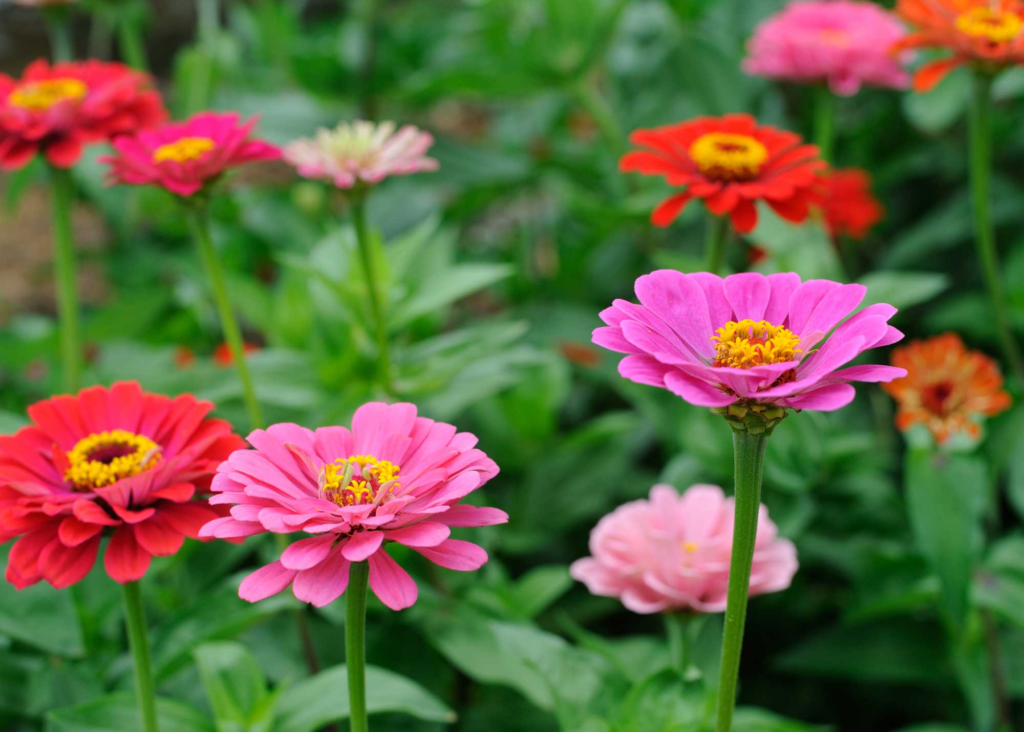
9. The Four-Season Fence Framework: Zinnias as Summer Stars in a Year-Round Design
While zinnias deliver outstanding summer performance, their annual nature means they’re absent from the garden for much of the year in most American climate zones. A thoughtful four-season fence design incorporates zinnias as summer stars within a framework that provides structure and interest throughout the year.
This approach requires more initial investment but delivers long-term rewards through continuous seasonal beauty. The foundation of a four-season fence garden consists of:
Structural Elements: Install permanent features like decorative posts, obelisks, or trellises at regular intervals along the fence to provide winter interest.
Evergreen Anchors: Incorporate compact evergreen shrubs strategically placed to create year-round structure and backdrop for seasonal elements.
Spring Bulb Layer: Plant daffodils, tulips, and alliums for early-season color before zinnias emerge.
Summer Zinnia Focus: Allocate specific zones for zinnias as the summer showcase elements.
Fall Interest Plants: Include ornamental grasses, sedum, and late-blooming perennials for autumn transition.
Winter Structure: Select plants with interesting seed heads, bark, or persistent structure for winter appeal.
The key to success with this approach lies in thoughtful allocation of space and clear seasonal transitions. Designate approximately 40-50% of your fence garden specifically for summer annual displays featuring zinnias, using permanent elements to subdivide the space into distinct garden rooms or sections.
For example, a 40-foot fence might include:
Two 8-foot “rooms” dedicated to summer zinnia displays Two 6-foot transitional sections with evergreen structure and perennial foundations Two 6-foot sections with year-round decorative elements and seasonal accents
This segmented approach allows you to refresh and replant the zinnia sections each year while maintaining continuity through the permanent elements. The United States National Arboretum offers resources on designing four-season interest gardens for different regions: https://www.usna.usda.gov/gardens/garden-design.
For maximum impact, consider these implementation strategies:
Consistent Color Theme: Select a color palette that transitions harmoniously through the seasons, perhaps focusing on warm tones (reds, oranges, yellows) or cool tones (blues, purples, silvers).
Textural Contrast: Incorporate plants with distinctive textural qualities that complement the clean simplicity of zinnia foliage and blooms.
Photographic Documentation: Create a photographic record of your fence garden through the seasons to identify gaps in interest and refine your approach over time.
The four-season fence framework transforms a potential single-season feature into a continuous garden highlight that rewards attention throughout the year while still showcasing the exceptional summer performance of your carefully selected zinnias.
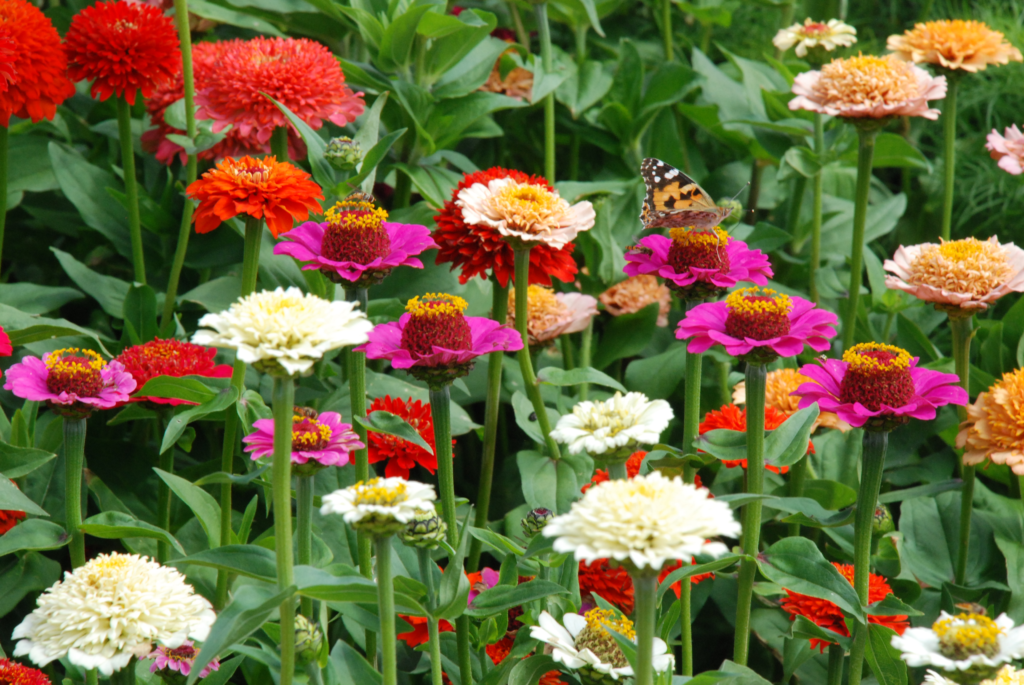
10. The Fence Foundation: Using Zinnias to Establish Long-Term Garden Structure
For gardeners establishing new landscapes or completely reimagining existing ones, zinnias can serve as valuable “placeholder” plants while you develop more permanent garden structures. This approach leverages the quick growth and reliable performance of zinnias to create immediate impact while allowing time for planning and implementing long-term landscape elements.
The fence foundation approach differs from others discussed previously in its intentionally transitional nature. Rather than representing a final design, this method uses zinnias strategically to:
Test Growing Conditions: Evaluate sun exposure, soil quality, and microclimate variations along your fence line before investing in expensive perennials.
Experiment with Color Schemes: Try different color combinations to determine what works best with your home’s exterior and existing landscape elements.
Build Soil Quality: Use the season of zinnia growth to incorporate organic matter and improve soil structure in future permanent planting areas.
Develop Garden Vision: Create a full-scale “mock-up” of your eventual garden plan using annuals before committing to permanent plantings.
To implement this approach effectively, create a simple scale drawing of your fence line and develop a “master plan” for your eventual permanent garden. Identify areas intended for different eventual purposes: shrub borders, perennial beds, specimen tree locations, etc. Then, select zinnia varieties that approximate the eventual height, color, or texture of your planned permanent elements.
For example, if you plan to eventually install a mixed shrub border with varying heights, you might use:
‘Benary’s Giant’ zinnias (36-48″) in areas planned for taller shrubs ‘Oklahoma’ series (24-30″) where medium shrubs will eventually go ‘Zahara’ series (12-18″) to represent planned locations for perennials or ground covers
This approach provides immediate color while allowing you to evaluate how different heights and visual masses work in your specific landscape context. The flexibility of annual zinnias means you can adjust your plan each season based on what you learn, refining your vision before making larger investments in permanent plants.
For enhanced effectiveness, consider these implementation strategies:
Photo Documentation: Take regular photographs from consistent vantage points to evaluate the visual impact of different elements.
Phased Transition: Gradually replace sections of zinnias with permanent plants over multiple seasons, maintaining a colorful garden while implementing your long-term vision.
Soil Building: Use zinnia seasons to implement soil improvement strategies like cover cropping in the off-season or composting in place.
The fence foundation approach transforms the often-daunting process of establishing a new garden into a methodical, low-risk progression that provides beauty from the first season while working toward a thoughtfully developed long-term vision.
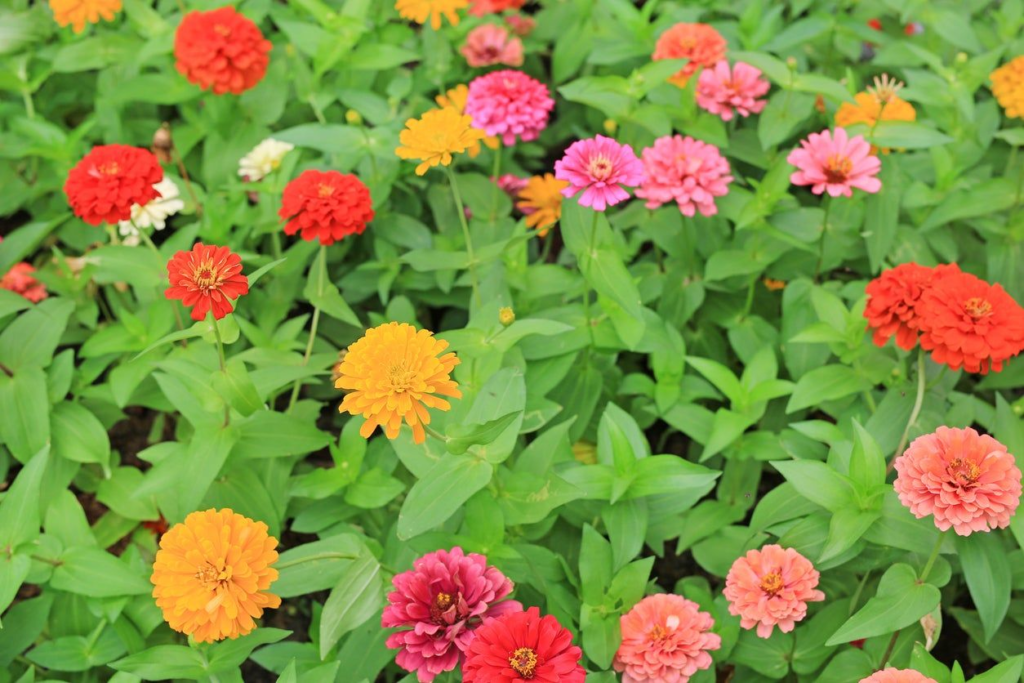
Conclusion: Creating Your Personal Zinnia Fence Garden Paradise
Throughout this exploration of ten distinctive approaches to zinnia fence gardening, certain fundamental principles emerge that can guide your personal implementation. Regardless of which specific method resonates most strongly with your aesthetic preferences and practical needs, consider these universal guidelines:
Start with Soil: Take time to properly prepare your fence-line bed with adequate organic matter and appropriate drainage. The USDA Natural Resources Conservation Service provides regional soil guides at https://www.nrcs.usda.gov/conservation-basics/natural-resource-concerns/soils.
Right Plant, Right Place: Select zinnia varieties appropriate to your specific conditions—sun exposure, climate zone, and available maintenance time.
Thoughtful Planning: Develop a clear vision before purchasing seeds or plants, considering both immediate visual impact and long-term garden evolution.
Maintenance Rhythm: Establish regular deadheading, watering, and monitoring practices that keep your fence garden looking its best throughout the season.
Personal Expression: Above all, let your fence garden reflect your unique preferences and lifestyle needs rather than rigidly adhering to prescribed formulas.
Your fence line represents a canvas for creative expression through gardening, offering opportunities to enhance your property’s appearance, increase your enjoyment of outdoor spaces, and contribute positively to your local ecosystem. Zinnias, with their remarkable adaptability and visual impact, provide an accessible medium for transforming this often-overlooked space into a defining feature of your landscape.
Whether you choose the structured elegance of a color-block design, the ecological benefits of a pollinator highway, or the practical advantages of a cutting garden, your zinnia fence garden will bring months of colorful enhancement to your property while expressing your personal gardening style. The fence that once simply marked a boundary can become a showcase for your gardening passion and a source of daily joy throughout the growing season.
By implementing the ideas explored in this guide, you transform not just your fence line but your entire relationship with your outdoor space, creating a more beautiful, functional, and personally meaningful garden environment that enhances your property and enriches your life.
